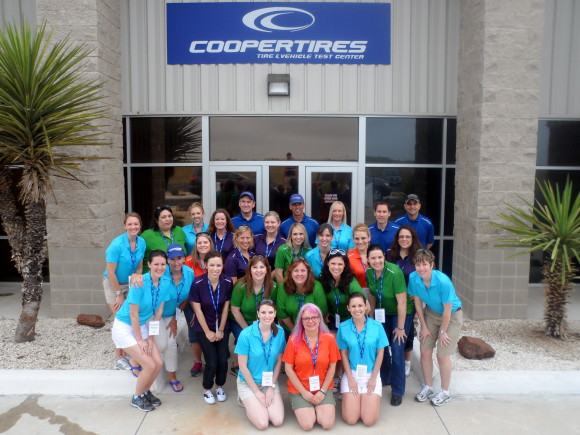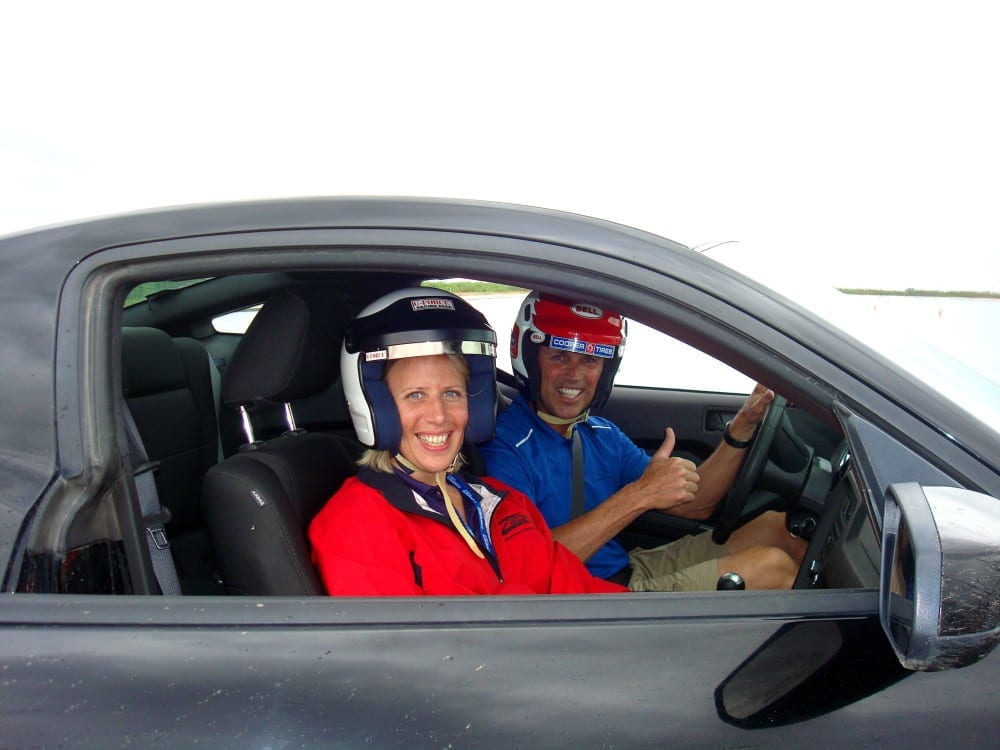We recently attended the Cooper Tire Super Mom Ride-N-Drive where we got to burn some rubber and learn many new things about safety and maintaining our tires! We also got to do some hot laps with famed Johnny Unser. We even had our knowledge handed to us during the “Busy Mommy” distracted driving obstacle course.
There is so much I learned from this tips and I’d love to share some tips with you below. But first, look how great we all look!


Here is a video where we got the chance to show-off our driving knowledge:
Tire Safety Tips from Cooper Tire
Checking tread and monitoring tire pressure before road trips takes less than ten minutes with these do-it-yourself tips from Cooper Tire:
As a general rule, the deeper the depth, the better. Tire tread depth should be more than 2/32 of an inch deep all around the tire. Drivers can check tread depth by inserting the edge of a U.S. penny in between the tread, with Lincoln going in headfirst. If the top of Lincoln’s head is covered by tread, there is at least a minimum acceptable amount of tread. If the top of his head is visible at any location on the tire, it is time to replace the tire.
While examining the tread, also look for signs of uneven wear or damage, including cuts, cracks, splits, punctures and bulges. These conditions shorten the life of tires and could cause further tire damage if left unnoticed.
Drivers should follow the guidelines found in the vehicle owner’s manual or tire placard (or sticker) attached to the vehicle door edge to determine the correct air pressure for their vehicle’s tires. It is a common misconception that the tire pressure listed on the sidewall is the optimal pressure – in reality, it is the maximum pressure.
Air pressure should be checked when the tires are completely cool.
If any of these checks signal a need for tire maintenance, or if drivers are doubtful about the condition of tires, vehicles should be brought to a tire dealer for a professional inspection.
Hot, summer weather puts stress on all vehicle components, including tire pressure. Follow these tips to monitor vehicle changes in summer heat:
Hot, summer weather can affect the rate at which the tire loses air. Tires can lose more than two pounds of air pressure per month in the summer heat, so check tire pressure regularly as underinflation is the leading cause of tire failure.
Make sure engine oil, transmission fluid, power-steering fluid and brake fluid are all at recommended levels.
Examine the vehicle’s cooling system to avoid overheating.
When the engine is still cool, check the level of coolant in the radiator by looking for the plastic overflow tank under the hood. Add fluid before driving if levels are low.
Check for any loose connections that may need tightening and radiator hoses that feel “spongy,” as they will need replacing.
When packing up for a road trip, consider these vehicle loading and overloading tips:
Before packing the trunk and the roof, check out the vehicle manufacturer’s recommendations for loading the vehicle, which can be found on the vehicle information placard located on the vehicle door edge or in the vehicle owners’ manual. Be aware that passengers count towards the total recommended vehicle weight.
Overloading the vehicle creates excessive heat inside tires, which increases tread wear and stress.
Tires and wheels that are off-balance or misaligned can cause uneven wear and other problems, especially on long road trips in a fully packed vehicle. Have a mechanic inspect vehicle alignment to avoid these issues.
With sunny skies and warmer temperatures also comes thunderstorms and slippery roads. Use caution any time roads are wet, as both deep and shallow layers of water can cause hydroplaning.
These safe-driving tips can help avoid hydroplaning on wet roads:
Inspect tire tread regularly to avoid losing traction on wet roads due to worn tires.
Ensure tires are properly inflated to help increase control on wet roads.
Check the alignment and balance of tires, ensuring vehicles are properly equipped should a skid occur.
Drive at a slower, safe speed, as wet traction is considerably reduced at higher speeds.
Stay out of wheel ruts created by cars ahead, as rainwater collects in them and heightens the possibility of hydroplaning.
Do not brake or turn when recovering from hydroplaning.
For more information on proper tire maintenance, visit www.coopertire.com.
Modern Day Moms
Modern Day Moms is an award-winning publication centered around motherhood that is real and unfiltered. Basically, we don't sugarcoat anything and aren't afraid to tell you the truth. Let's be best friends, we will make you feel more normal.


Leave a Comment